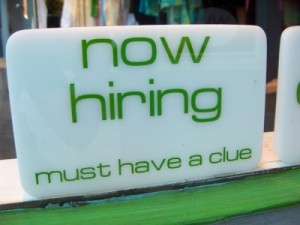Here is a simple test to pinpoint the real source of your help desk turnover. List all of your personnel who have turned-over in the past year. Take that list to your supervisors and ask them the following question – “If you could have any of these employees back, which ones would you choose?” If they tell you “none of them” you don’t have a management problem, you have a hiring problem.
 Nine times out of ten the real reason for help desk turnover is not having an effective, consistent hiring process. That process needs to include:
Nine times out of ten the real reason for help desk turnover is not having an effective, consistent hiring process. That process needs to include:
Job Profiling: You want to identify your minimum requirements but you need to be careful not to set the bar higher than it really needs to be. Rank your current employees’ performance, take a look at their education and experience, have them take any tests you will use on applicants to determine appropriate scores and use a job profiling tool like DISC or McQuaig.
Advertising: Keep ads simple and factual. The most import pieces of information are the position, hours, location and pay rate. If these parameters don’t suit them, you don’t want them to respond. You can avoid plowing through tons of useless candidates. Also include a link to the employment page of your website for additional details, requirements and forms.
Website Employment Page: This is where you can give more details on the skills and experience you are looking for. Be specific and let them know what they will be tested on. If you are going to do a criminal background check and drug testing, list that too. This serves as another filter that keeps candidates who can’t pass your testing from applying.
Initial Phone Interview: If a candidate looks good on paper, the next step is a phone interview. They are applying for a phone job. If they stink in your first couple of minutes on the phone, you will have saved yourself the time and trouble of an in-person interview.
Skills Testing: Candidates should pass your skills testing before they qualify for an in-person interview. I also suggest that your trainer spend some time teaching an applicant how to open a basic ticket in the application you use for documenting calls. Candidates should then handle some test calls made by other employees. Rate them on how well they follow instructions and learn while they are performing actual job functions.
In-Person Behavioral Interviews: Behavioral interviews should target the values and behaviors you can’t do without. Ask for specific examples of how they handled actual, not hypothetical, situations (ex. handled a difficult caller, disagreed with a supervisor, etc.). You are not looking for a perfect response. You are looking for a response that was appropriate for the situation.
Reference Checking: During an in-person interview you need to ask for both business references (their direct supervisor) and personal references (people who know them well). This is your opportunity to find out how an applicant actually performed on the job and confirm the information they gave you during their behavioral interview.
Behavioral Surveys: DISC, McQuaig and other testing services can also provide you with behavioral surveys. This is a questionnaire that will tell you how a candidate prefers to work. What their natural tendencies are. You can compare this against the Job Profile to see how well a candidate’s preferred behavior matches your job. Candidates don’t have to be a perfect fit, but it shows you how much they would have to stretch outside of their comfort zone to perform their duties.
Criminal Background Checks & Drug Testing: If your employees are going to have access to client data and security information, this is a must. If you ever have a problem, and you can’t show you performed appropriate due diligence, you could have a serious legal issue. This type of testing will also weed out a lot of potential problems with reliability and appropriate conduct with callers and co-workers.
Do all of these steps take a lot of time and money? Yes, they do, but nowhere near the costs associated with turnover – overtime to fill holes, more advertising, screening, training, etc.
What could you change about your current hiring process to improve future retention?
This blog was written by Laurie Leonard, the President of SUITE 1000, a U.S. based national telephone answering service, inbound call center and outsourced call center service. Her company has specialized in handling legal intake, sales leads, email lead response, appointment scheduling, customer service and help desk calls for over 20 years.
Copyright © 2025 SUITE 1000. All rights reserved.

